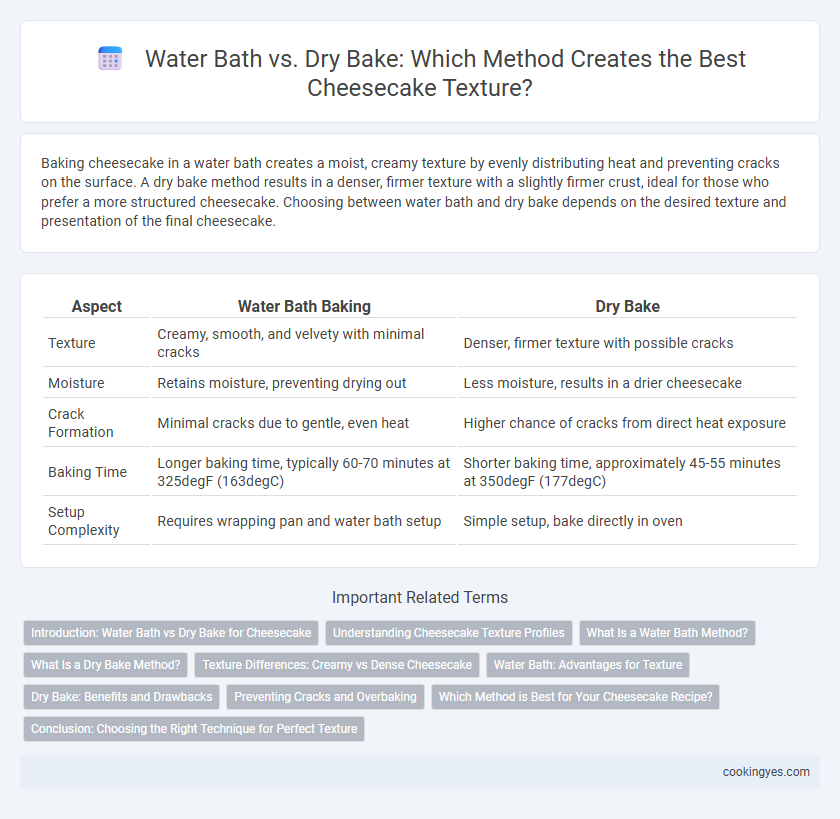Baking cheesecake in a water bath creates a moist, creamy texture by evenly distributing heat and preventing cracks on the surface. A dry bake method results in a denser, firmer texture with a slightly firmer crust, ideal for those who prefer a more structured cheesecake. Choosing between water bath and dry bake depends on the desired texture and presentation of the final cheesecake.
Table of Comparison
| Aspect | Water Bath Baking | Dry Bake |
|---|---|---|
| Texture | Creamy, smooth, and velvety with minimal cracks | Denser, firmer texture with possible cracks |
| Moisture | Retains moisture, preventing drying out | Less moisture, results in a drier cheesecake |
| Crack Formation | Minimal cracks due to gentle, even heat | Higher chance of cracks from direct heat exposure |
| Baking Time | Longer baking time, typically 60-70 minutes at 325degF (163degC) | Shorter baking time, approximately 45-55 minutes at 350degF (177degC) |
| Setup Complexity | Requires wrapping pan and water bath setup | Simple setup, bake directly in oven |
Introduction: Water Bath vs Dry Bake for Cheesecake
Water bath baking creates a moist environment that prevents the cheesecake from cracking and produces a smooth, creamy texture. Dry baking results in a firmer, denser cheesecake with a slightly cracked surface but a rich, intense flavor. Choosing between water bath and dry bake depends on the desired balance between texture and appearance.
Understanding Cheesecake Texture Profiles
Water bath baking produces a smooth, creamy cheesecake texture by providing gentle, even heat that prevents cracking and curdling. Dry bake methods create a denser, firmer texture with a slightly crumbly edge due to direct oven heat exposure. Understanding these texture profiles helps bakers choose the right technique based on the desired mouthfeel and presentation of the cheesecake.
What Is a Water Bath Method?
A water bath method involves placing the cheesecake pan in a larger pan filled with hot water before baking, ensuring even heat distribution and preventing cracking. This technique creates a moist environment that gently cooks the cheesecake, resulting in a smooth, creamy texture. In contrast to dry baking, the water bath helps maintain consistent temperature and reduces the risk of overbaking.
What Is a Dry Bake Method?
The dry bake method involves baking the cheesecake without using a water bath, resulting in a denser and firmer texture with a slightly browned, golden top. This technique allows for a richer, more custard-like consistency compared to the creamy, smooth texture achieved by a water bath. Dry baking is ideal for those who prefer a robust cheesecake with a bit of a crust on the edges and a less delicate surface.
Texture Differences: Creamy vs Dense Cheesecake
A water bath creates a moist, gentle heat environment that results in a creamy, smooth cheesecake texture by preventing cracks and uneven cooking. Dry baking exposes the cheesecake to direct heat, often producing a denser, firmer texture with a slightly drier mouthfeel. Choosing between water bath and dry bake methods directly impacts the final cheesecake's softness and richness.
Water Bath: Advantages for Texture
Water bath baking maintains consistent, gentle heat that prevents the cheesecake from cracking and ensures a smooth, creamy texture. This method reduces oven temperature fluctuations, resulting in a moist and tender crumb with a delicate, custard-like finish. The steam generated in the water bath also helps retain moisture, enhancing the overall richness and silkiness of the cheesecake.
Dry Bake: Benefits and Drawbacks
Dry bake method for cheesecake produces a firmer, denser texture with a slightly golden exterior, appealing to those who prefer a more traditional, sliceable consistency. This technique minimizes moisture content, which can enhance flavor concentration but increases the risk of cracking without careful temperature control. While it offers convenience by eliminating the need for a water bath setup, dry baking requires precise oven calibration to prevent uneven cooking and dry edges.
Preventing Cracks and Overbaking
Using a water bath for cheesecake baking creates a moist, gentle heat environment that prevents cracks by minimizing temperature fluctuations and ensuring even baking. Dry baking can lead to overbaking and drying out the edges, increasing the risk of surface cracks and a dense texture. Maintaining consistent moisture with a water bath produces a creamy, smooth cheesecake with a flawless appearance.
Which Method is Best for Your Cheesecake Recipe?
Water bath baking prevents cracks by providing gentle, even heat and moisture, resulting in a smooth, creamy cheesecake texture. Dry baking produces a denser, firmer cheesecake with a slightly drier crumb, ideal for recipes requiring a more structured slice. Choosing the best method depends on your desired texture and recipe specifics, with water baths favored for delicate, silky cheesecakes and dry baking preferred for rich, robust styles.
Conclusion: Choosing the Right Technique for Perfect Texture
Water bath baking ensures a creamy, smooth cheesecake texture by providing gentle, even heat and preventing cracks, ideal for dense and silky results. Dry baking yields a firmer, denser texture with a slightly crumbly edge, preferred for more structured cheesecake varieties. Selecting the right technique depends on the desired balance between moisture and firmness, with water baths favored for rich, velvety consistency and dry baking suited for robust, sliceable cakes.
Water bath vs dry bake for cheesecake texture Infographic

 cookingyes.com
cookingyes.com